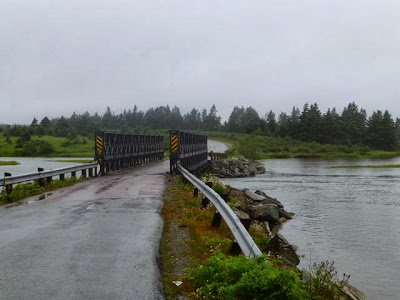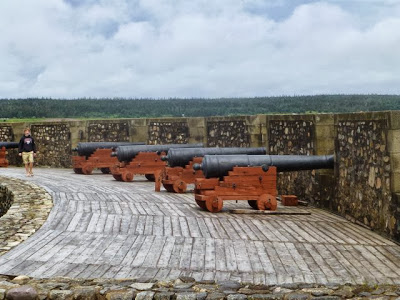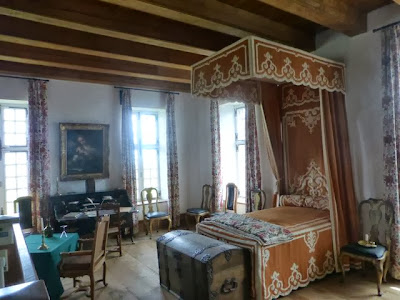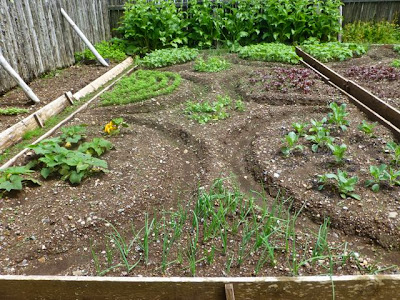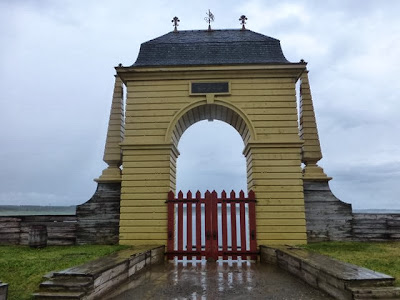![]() |
A soaked tent set up on soft moss covered bank with one of the greatest views in the trip at
Battery Provincial Park |
We escaped the rains on Prince Edward Island and paid our $44.00 toll to exit the Confederation Bridge on a clammy and wet day. Little did we know that at our destination the rain would be of tropical proportions. We also had a 300 plus mile long drive ahead of us to get our next campsite. The drive initially proved beautiful with all manner of villages and fishing towns that by now had become the norm. We had a few stops but we were headed to the principal location of our Canadian adventure - Cape Breton and the Cabot trail. The Trans-Canadian highways we had experienced were beautiful multi lane roads without ever a toll. This far north and with a limited population at hand, even the Trans-Canadian Highway was just a two lane road with a passing lane every so often.
![]()
Marti and I had each driven our own hybrid cars from Florida. We had started the journeys with different itineraries and had linked up in Maine for the 4th of July. We had planned part of the camping trip in Florida and had left wiggle room to adapt to opportunities. We had envisioned about three weeks of camping. Eventually she would return to Florida and I would continue further north into Quebec to visit the old French cities of Quebec and Montreal. I would then do the rounds visiting friends near Ottawa, Vermont, New York and my old home in New Jersey.
![]() |
| Another wet day on the road to Louisburg |
One of the discoveries we made along the trip was that the reconstructed Fortress of Louisburg was celebrating 300 year anniversary (well, sort of) and we were headed there the day of the opening festivities. I say sort of because Louisburg, the principal French settlement on Cape Breton Island (then called Ile Royale {Royal Island} was constructed in 1713 and burned down by the British in 1758. The Canadian Government began a 25 million dollar reconstruction in 1965. Today the finest craftsman have recreated and reinterpreted historic Louisburg for all to appreciate.
![]() |
| Main complex of Louisburg seen from visitor center |
A further history lesson is required. Cape Breton is today attached by a causeway to Nova Scotia. In its history it was an island part of the French possessions in North America. In 1713 the Treaty of Utrecht (a Dutch city) brought about a peace between Great Britain and France and its ally Spain. Louis XIV ceded Nova Scotia and New Foundland and Rupert's Land (parts of today Ontario, Manitoba and Nunavut) Spain ceeded Spanish Netherlands, Naples, Sardinia, Milan to the Holy Roman Emperor and Gibraltar and Minorca to Great Britain. The land grab that followed by the British eventually laying siege to all French possessions in North America ended by the Battle of the Fields Abraham in 1759. This battle fought outside the walls of Quebec City in farm fields of a man named Abraham lasted all of 15 minutes with the French surrendering (well, sort of){that story when we get to Quebec}.
The following are images of the visit. We arrived during a partially sunny day and then the skies opened up and it poured. In many ways we experienced the place like the French settlers who lived there so long ago. Part of the interpretive nature had people in various buildings and locations telling about fishing, soldiering and surviving in Louisburg.
![]()
![]() |
| guard in character searching for British spies |
![]() |
| even the crest looks like Louis 14 |
![]() |
| All the canons did not manage to defend the fort as the British siege came from an unprotected swamp |
![]() |
| fine central building housing barracks, governor and chapel |
![]() |
| massive timber stairs into governor's apartment |
![]() |
| Governor's dining room |
![]() |
| Governor's bedchamber |
![]() |
| Chapel |
![]() |
| recreated formal garden |
![]() |
| Celebration participants |
![]() |
| Painting of a sea battle outside fortress |
![]() |
| Royal Gate in honor of Louis 14 in case he visited |
Fiske Kimball was a talented architect enlisted by John D Rockefeller Jr to create Williamsburg Virginia in the early 1930's. This new way of creating art, history and commerce served as a good example for the Canadian's government effort to recreate a historic legacy and provide employment to an area that had been depressed due to loss of employment with the closing of many mines in Nova Scotia. It is hard to imagine today that this historic photograph was the starting point of the study and interest of historians, archeologists and architects to recreate the Louisburg we see today. Happy 300th Birthday, sort of.
![]() |
Massive warehouse
|

